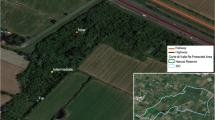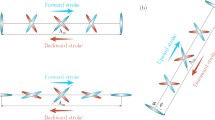Abstract
In this paper, the flocking flight of Northern Bald Ibises (Geronticus eremita) and their induced drag during the flock are investigated. Northern Bald Ibises are long-range migratory birds. These birds fly in an echelon and V-shaped formation, possibly to reduce their drag; therefore, as a result, they may save energy to fly farther. The aerodynamic drag forces of each individual bird and the flock are modeled theoretically. Extensive analysis shows how, during flocking flight, the drag force reduces as the size of the flock increases. Additionally, wingtip spacing effects on the total drag of the flock are investigated. The fraction of drag reduction of individual ibises is also analyzed. Four initial arrangement scenarios are considered for flocks of ibises of different sizes in this study. Two shuffling algorithms are applied for position switching and energy balancing of the ibises during their flight. It is suggested that ibises can save energy by means of different arrangements of flock members during long flights. The results indicate that how different sizes of the birds can manipulate their positions to fly further and save energy during migration.















Similar content being viewed by others
References
Hassanalian, M., Abdelmoula, H., Ayed, S. B., & Abdelkefi, A. (2017). Thermal impact of migrating birds’ wing color on their flight performance: Possibility of new generation of biologically inspired drones. Journal of Thermal Biology, 66, 27–32.
Hassanalian, M., Throneberry, G., Ali, M., Ayed, S. B., & Abdelkefi, A. (2018). Role of wing color and seasonal changes in ambient temperature and solar irradiation on predicted flight efficiency of the albatross. Journal of Thermal Biology, 71, 112–122.
Hassanalian, M., Ayed, S. B., Ali, M., Houde, P., Hocut, C., & Abdelkefi, A. (2018). Insights on the thermal impacts of wing colorization of migrating birds on their skin friction drag and the choice of their flight route. Journal of Thermal Biology, 72, 81–93.
Hassanalian, M., Abdelmoula, H., Mohammadi, S., Bakhtiyarov, S., Goerlich, J., & Javed, U. (2019). Aquatic animal colors and skin temperature: Biology’s selection for reducing oceanic dolphin’s skin friction drag. Journal of Thermal Biology, 84, 292–310.
Duriez, O., Peron, G., Gremillet, D., Sforzi, A., & Monti, F. (2018). Migrating ospreys use thermal uplift over the open sea. Biology Letters, 14, 20180687.
Williams, H. J., King, A. J., Duriez, O., Börger, L., & Shepard, E. L. (2018). Social eavesdropping allows for a more risky gliding strategy by thermal-soaring birds. Journal of the Royal Society Interface, 15, 20180578.
Felicísimo, Á. M., Muñoz, J., & González-Solis, J. (2008). Ocean surface winds drive dynamics of transoceanic aerial movements. PLoS One, 3, e2928.
Mirzaeinia, A., Heppner, F., & Hassanalian, M. (2020). An analytical study on leader and follower switching in V-shaped Canada Goose flocks for energy management purposes. Swarm Intelligence, 14, 117–141.
Völkl, B., & Fritz, J. (2017). Relation between travel strategy and social organization of migrating birds with special consideration of formation flight in the northern bald ibis. Philosophical Transactions of the Royal Society B: Biological Sciences, 372, 20160235.
Gill, R. E., Jr., Tibbitts, T. L., Douglas, D. C., Handel, C. M., Mulcahy, D. M., Gottschalck, J. C., Warnock, N., McCaffery, B. J., Battley, P. F., & Piersma, T. (2009). Extreme endurance flights by landbirds crossing the Pacific Ocean: Ecological corridor rather than barrier? Proceedings of the Royal Society B: Biological Sciences, 276, 447–457.
Ferguson-Lees, J., & Christie, D. A. (2001). Raptors of the world. Houghton Mifflin Harcourt.
Bairlein, F., Fritz, J., Scope, A., Schwendenwein, I., Stanclova, G., van Dijk, G., Meijer, H. A., Verhulst, S., & Dittami, J. (2015). Energy expenditure and metabolic changes of free-flying migrating northern bald ibis. PloS One, 10, e0134433.
Lissaman, P. B., & Shollenberger, C. A. (1970). Formation flight of birds. Science, 168, 1003–1005.
Badgerow, J. P., & Hainsworth, F. R. (1981). Energy savings through formation flight? A re-examination of the vee formation. Journal of Theoretical Biology, 93, 41–52.
Hummel, D. (1983). Aerodynamic aspects of formation flight in birds. Journal of Theoretical Biology, 104, 321–347.
Hainsworth, F. R. (1987). Precision and dynamics of positioning by Canada geese flying in formation. Journal of Experimental Biology, 128, 445–462.
Seiler, P., Pant, A., & Hedrick, K. (2002) Analysis of bird formations. Proceedings of the 41st IEEE Conference on Decision and Control (pp. 118–123). IEEE.
Andersson, M., & Wallander, J. (2004). Kin selection and reciprocity in flight formation? Behavioral Ecology, 15, 158–162.
Thien, H. P., Moelyadi, M. A., & Muhammad, H. (2007). Effects of leaders position and shape on aerodynamic performances of V flight formation (pp. 43–49). ICIUS.
Portugal, S. J., Hubel, T. Y., Fritz, J., Heese, S., Trobe, D., Voelkl, B., Hailes, S., Wilson, A. M., & Usherwood, J. R. (2014). Upwash exploitation and downwash avoidance by flap phasing in ibis formation flight. Nature, 505, 399–402.
Voelkl, B., Portugal, S. J., Unsöld, M., Usherwood, J. R., Wilson, A. M., & Fritz, J. (2015). Matching times of leading and following suggest cooperation through direct reciprocity during V-formation flight in ibis. Proceedings of the National Academy of Sciences, 112, 2115–2120.
Mirzaeinia, A., Hassanalian, M., Lee, K., & Mirzaeinia, M. (2019). Energy conservation of V-shaped swarming fixed-wing drones through position reconfiguration. Aerospace Science and Technology, 94, 105398.
Reason for Hope, Migratory Pattern of the Northern Bald Ibis. [2019-07-14], http://waldrapp.eu/index.php/en/northern-bald-ibis/migration
Northern Bald Ibis Geronticus eremita. [2019-07-14], http://datazone.birdlife.org/species/factsheet/northern-bald-ibis-geronticus-eremita/details
Sperger, C., Heller, A., Völkl, B., & Fritz, J. (2017). Flight strategies of migrating northern bald ibises—analysis of GPS data during human-led migration flights. Journal für Angewandte Geoinformatik, 3, 62–72.
Kshatriya, M., & Blake, R. W. (1992). Theoretical model of the optimum flock size of birds flying in formation. Journal of Theoretical Biology, 157, 135–174.
Anderson, J. D., Jr. (2016). Fundamentals of aerodynamics. Tata McGraw-Hill Education.
Author information
Authors and Affiliations
Corresponding author
Ethics declarations
Conflict of interest
The authors declare that they have no conflict of interest.
Additional information
Publisher's Note
Springer Nature remains neutral with regard to jurisdictional claims in published maps and institutional affiliations.
Rights and permissions
About this article
Cite this article
Hassanalian, M., Mirzaeinia, A., Bawana, N. et al. Energy Management of Echelon Flying Northern Bald Ibises with Different Wingspans and Variable Wingtip Spacing. J Bionic Eng 19, 44–61 (2022). https://doi.org/10.1007/s42235-021-00107-7
Received:
Revised:
Accepted:
Published:
Issue Date:
DOI: https://doi.org/10.1007/s42235-021-00107-7




